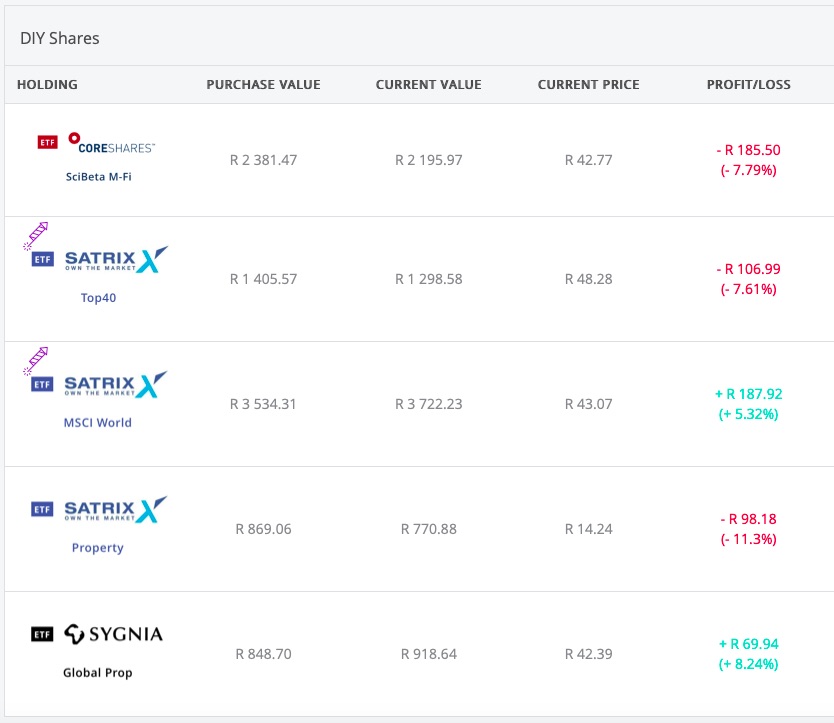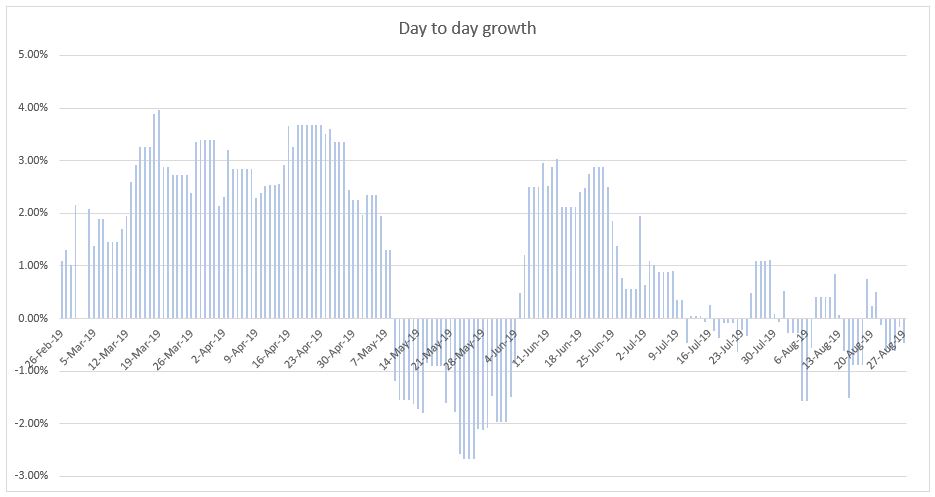This is the August 2019 update on my Easy Equities investment. I started this series in February 2019 and track my ETF investment each month. You can read about my first ETF investment (ever!).
My current Easy Equities investment

Up to date I have invested a total of R8,950 which is the total amount before any fees or costs. But, the actual value now is only R8,909.08 which means that I have lost money. This is similar to the month of May which also had a negative growth, I suspect due to political events at that time.
Here are my actual Easy Equities investment values.

The table below shows the amounts that I invested since starting and I have calculated the interest I would have earned had the money been earning 5% interest in a bank account versus what it is really earning. As you see, my investments aren’t looking too healthy right now as my all-time average growth is -1.5%. Not good.

As you can imagine though, the index values go up and down daily. No need to over-analyze the the next graph, but it shows the daily growth (simply the value that I have invested versus the value at the end of the day). So it’s not compounding or doing anything too clever.
The point however is to see that the values go up and down all the time; there is a level of risk involved. However, passive investing (index investing) is for the long term and many big-time investors (eg Warren Buffet) swear by simple long-term index tracking funds.

The CoreShares SciBeta index
If you read my July ETF Update you would have seen that I was confused about what the CoreShares Top40 index change meant and what to do about it. They changed from an equally weighted Top40 index to a “smart beta” index which made me a little anxious. Since then though I’ve been doing a lot of research to understand the underlying index better.
The new CoreShares SciBeta (SMART ETF) tracks the Scientific Beta CS South-Africa Multi-Beta Multi-Strategy Six-Factor EW Index. This is seriously a long and over-complicated name but we can break it down as follows:
It’s Scientific as the methodology is well researched and documented with the initial research thesis dating back to the 70’s. The Beta refers to the measure of volatility and the movement versus a benchmark and the weighting is done in a “smart” way to diversity the undesired risks. And finally, the Multi-Factor part refers to the 6 factors that are taken into account in this index namely; size, value, momentum, low volatility, investment & profitability.
Basically (and this is a real high-level), the index uses 6 factors that are calculated using a combination of both publicly available accounting data from company results (such as profitability) as well as market data (such as price movements and share price volatility). The weighting of the 51 funds that make up the index is then automatically applied.
Although there is a very high level of automation and programming required, along with a significant amount of market and accounting data to be processed, this is not using Artificial Intelligence (AI). It’s simply rule-based calculations. So no emotions or speculation, simply tracking facts and figures based on 6 specific areas.
I like it actually so will simply stick with what I have. I also have some money invested in the Satrix Top 40 and I will follow both investments carefully. There are a few funds to choose when looking at Easy Equities top 40 index trackers, so best do your research.
Why are my investments doing so badly?
There’s no simple answer as to why my Easy Equities investment is currently doing badly. It’s a combination of local politics, instability in the country as well as international politics and the rantings of Mr Trump. We can speculate all day but it’s a little pointless.
Just know that the tide will turn again and in 20 years time this will probably just be a tiny blimp of the graph.
My investment strategy
My investment strategy currently is as follows:
- 25% Local Equities – CoreShares Sci-Beta (Smart Beta)
- 15% Local Equities – Satrix Top 40
- 10% Local Property – Satrix Property ETF
- 40% Offshore Equities – Satrix Worldwide
- 10% Offshore Property – Sygnia Global Property ETF
When investing additional funds I simply re-balance the ETFs to match my goal. Check this out if you aren’t sure about what ETF’s are.
Should I add crypto to my portfolio?
I’m currently thinking about whether or not to add crypto to my portfolio. I can do this on Easy Equities with the EC10 index fund. While I’m deciding this, have a look at this post on whether Bitcoin is a good investment.
Update: I did it. I have invested in EC10 on Easy Equities. You can read all about it in the September 2019 investment update.
To end
Tracking index funds on a month-to-month basis isn’t exactly the most exciting pastime but I am interested to see how this will pan out over a year. After that I’ll probably only do periodic updates to see how it’s going.
It’s always tempting to try and time the market; to buy at the right time and to sell and make huge profits. And then of course there’s the emotion that comes to play when stocks fall and markets change and you suddenly get scared and second-guess yourself.
The idea of passive investing is to simply choose a few indexes to track and then to do absolutely nothing besides contribute to the investment. Don’t sell, swap or stress. Just sit back and forget about it.
I’m clearly not following my own advice as I’m actively watching it, but I’m not going to sell or do anything drastic. I’m just watching it so that I can report back on how it’s performing.
Hope you find this useful. Please share comments below or catch me on social media.
Happy investing!



Thanks and great article, well it doesn’t really matter that much when you started but its consistency. I have been investing on ETFs since 2014 and I was lucky enough to be introduced to them by a colleague who was going to retirement that same year. That year was my first job, straight from university.
Looking at your investment, I would like to give one little piece of advice(not a financial advisor). The key to building long lasting wealth lies in:
-Pay yourself first
-Investing long term
-Paying lowest fees
-Select dividend paying ETFs
-Max your TFSA
-watch your money grow 😊.
By saying pay yourself first, I made a scheduled debit order, increasing it by 15-20% p/a to beat CPI. You have mastered the second point well already and that takes me to the 3rd point, pay the lowest fees. Did you know that you can get the same ETF which track the same index at say 100% lower TER than what you currently paying there (i.e 0.1% instead if 0.25%) ? I realized a huge benefit on my investment the day I became cost frugal.
On the select dividend paying ETFS, whether the market is low or up, you still get paid, sometimes 2 to 4 times a hear which boost your investment significantly. I also do this under my TFSA which really help.
On crypto currency, my portfolio holds about 40% crypto (Not bitcoin) which have proof of concept and proof of work and will change the entire world through blockchain. You just have to know which ones are those and internet is a great platform to get you started.
I really enjoy reading your blogs and keep It up, happy investing.